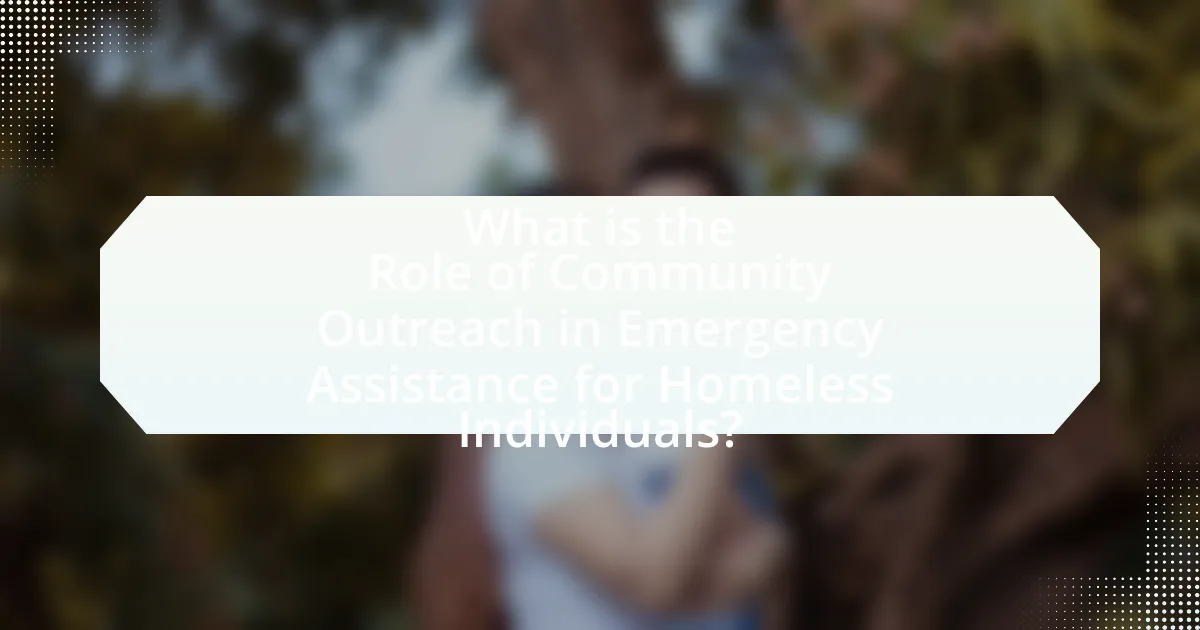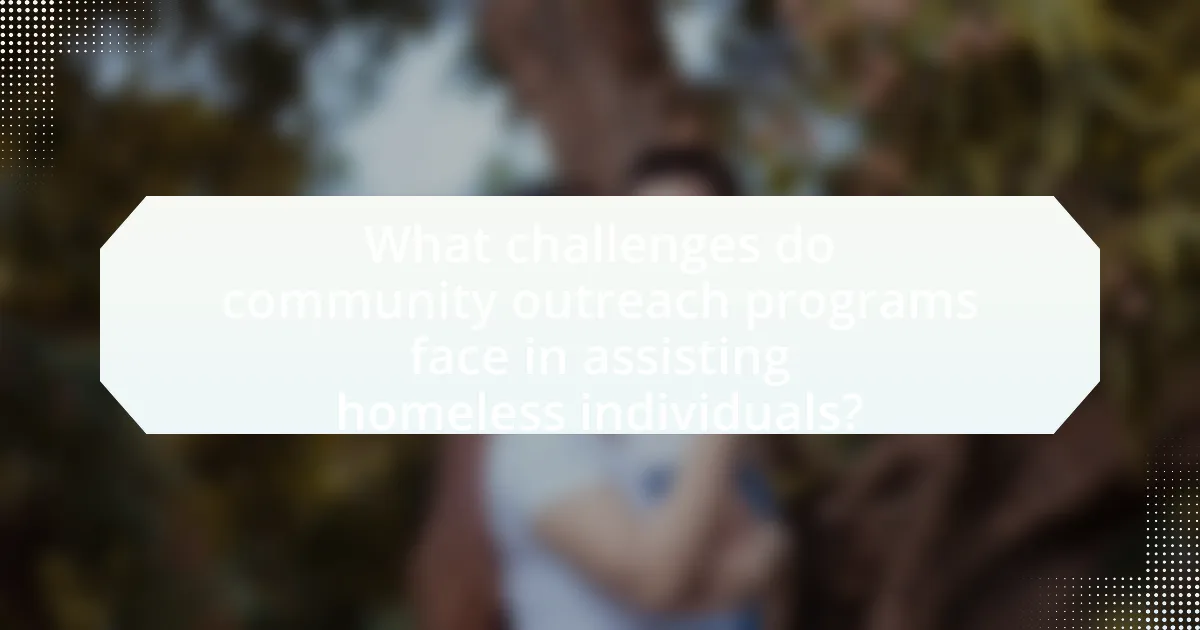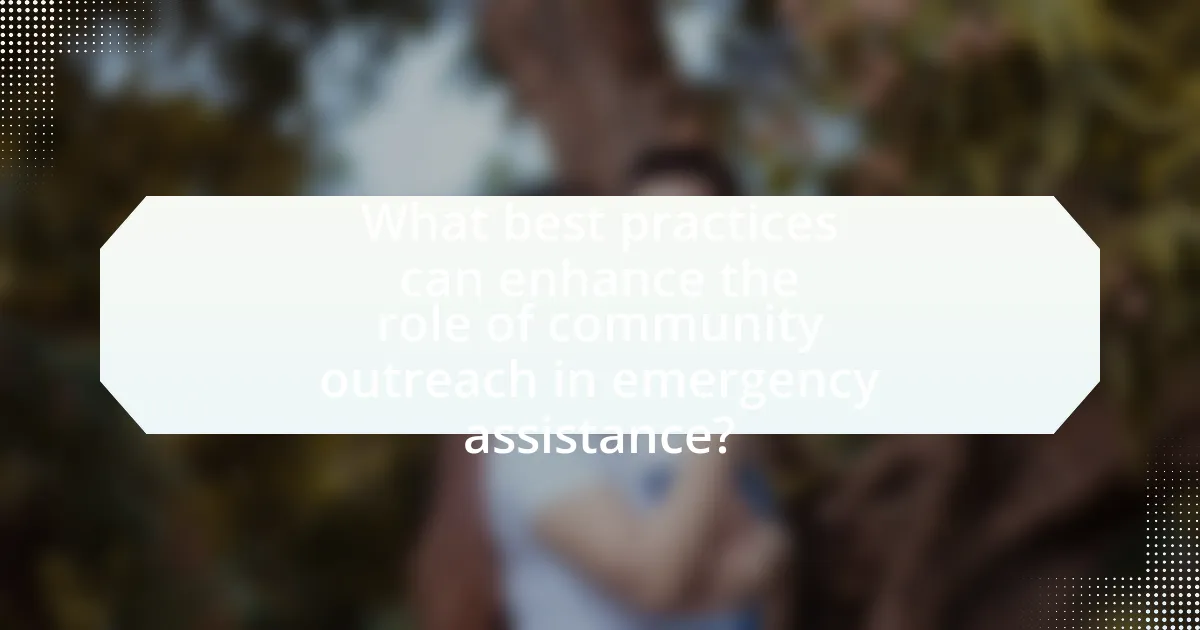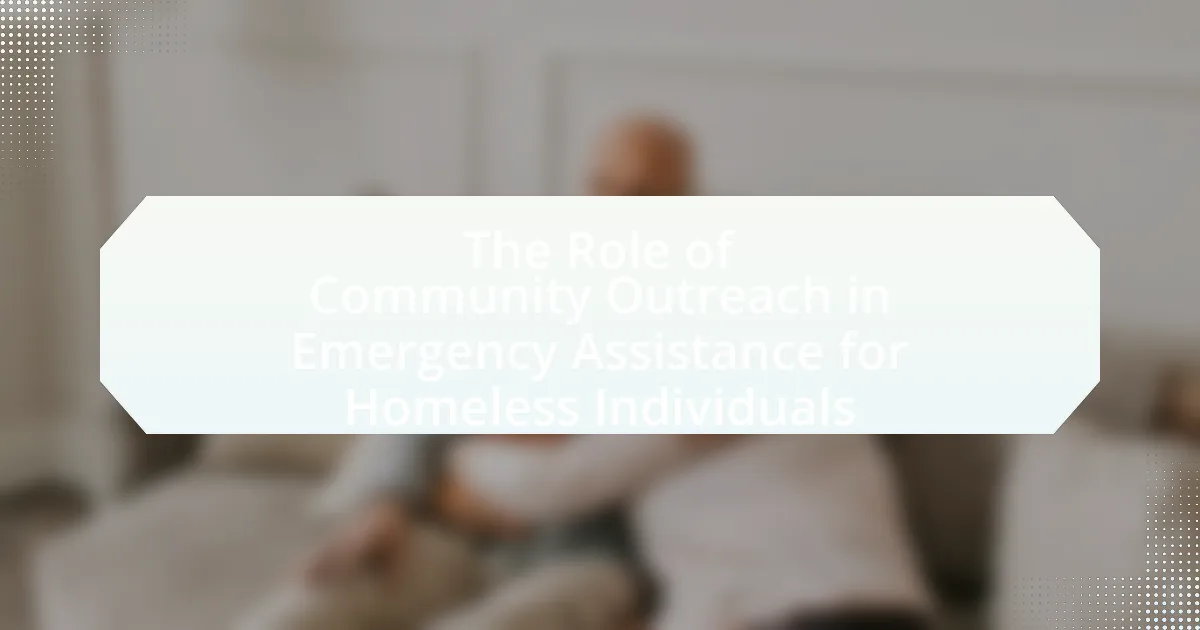Community outreach is a vital component of emergency assistance for homeless individuals, facilitating access to essential services such as food, shelter, and healthcare. The article explores how outreach programs effectively engage with homeless populations, identify their needs, and connect them with resources, significantly improving their chances of receiving housing assistance and long-term support. Key components of successful outreach include targeted communication strategies, community engagement, and evaluation mechanisms, while challenges such as funding limitations and stigma are also addressed. The role of partnerships and innovative approaches, including technology and volunteer involvement, are highlighted as crucial for enhancing outreach effectiveness and ultimately reducing homelessness in communities.

What is the Role of Community Outreach in Emergency Assistance for Homeless Individuals?
Community outreach plays a critical role in emergency assistance for homeless individuals by facilitating access to essential services and resources. Through outreach programs, organizations can identify and engage with homeless individuals, providing immediate support such as food, shelter, and medical care. For instance, studies show that outreach efforts can increase the likelihood of individuals receiving housing assistance by up to 50%, as they connect them with case managers and social services. Additionally, community outreach fosters trust and rapport, which are vital for encouraging homeless individuals to seek long-term solutions to their housing instability.
How does community outreach facilitate emergency assistance for homeless individuals?
Community outreach facilitates emergency assistance for homeless individuals by connecting them with essential resources and services. Outreach programs actively engage with homeless populations, identifying their immediate needs and providing access to shelters, food, healthcare, and social services. For example, studies show that outreach initiatives can increase the likelihood of individuals receiving timely assistance, as evidenced by a report from the National Alliance to End Homelessness, which found that targeted outreach efforts led to a 30% increase in service utilization among homeless individuals. This direct engagement not only addresses urgent needs but also fosters trust and encourages individuals to seek long-term support, ultimately improving their overall well-being.
What are the key components of effective community outreach programs?
Effective community outreach programs consist of clear objectives, targeted communication strategies, community engagement, and evaluation mechanisms. Clear objectives ensure that the program has specific goals, such as increasing awareness of services available to homeless individuals. Targeted communication strategies involve using appropriate channels to reach the intended audience, such as social media, flyers, or community meetings, which have been shown to enhance outreach effectiveness. Community engagement fosters trust and collaboration with local organizations and residents, which is crucial for understanding the needs of homeless individuals. Finally, evaluation mechanisms assess the program’s impact and effectiveness, allowing for adjustments based on feedback and outcomes, as evidenced by studies indicating that programs with robust evaluation processes are more successful in achieving their goals.
How do outreach programs identify and engage homeless individuals in need?
Outreach programs identify and engage homeless individuals in need through targeted strategies such as street outreach, collaboration with local organizations, and data collection. Street outreach involves trained personnel actively searching for homeless individuals in areas where they congregate, providing immediate assistance and resources. Collaboration with local shelters, food banks, and healthcare providers enhances outreach efforts by sharing information and resources, ensuring a comprehensive approach to support. Data collection, including surveys and assessments, helps programs understand the specific needs and demographics of the homeless population, allowing for tailored interventions. These methods are supported by studies indicating that direct engagement and resource availability significantly improve the likelihood of connecting homeless individuals with necessary services.
Why is community outreach essential in addressing homelessness?
Community outreach is essential in addressing homelessness because it facilitates direct engagement with individuals experiencing homelessness, allowing for tailored support and resources. Effective outreach programs connect homeless individuals with vital services such as housing assistance, healthcare, and employment opportunities, which are crucial for their reintegration into society. Research indicates that outreach efforts can significantly reduce homelessness; for instance, a study by the National Alliance to End Homelessness found that targeted outreach can lead to a 30% increase in access to housing services for homeless individuals. This demonstrates that community outreach not only raises awareness but also actively contributes to solving the issue of homelessness through direct intervention and support.
What impact does community outreach have on the lives of homeless individuals?
Community outreach significantly improves the lives of homeless individuals by providing essential resources and support systems. Outreach programs often connect homeless individuals with vital services such as food, shelter, healthcare, and job training, which can lead to increased stability and self-sufficiency. For instance, a study by the National Alliance to End Homelessness found that targeted outreach efforts can reduce homelessness by 30% in specific communities by facilitating access to housing and support services. This demonstrates that effective community outreach not only addresses immediate needs but also fosters long-term positive outcomes for homeless individuals.
How does community outreach contribute to reducing homelessness in communities?
Community outreach significantly contributes to reducing homelessness in communities by facilitating access to essential services and resources for individuals experiencing homelessness. Outreach programs connect homeless individuals with housing assistance, healthcare, job training, and social services, which are critical for their reintegration into society. For instance, a study by the National Alliance to End Homelessness found that targeted outreach efforts can lead to a 30% increase in the number of individuals accessing permanent housing solutions. By building trust and providing immediate support, community outreach helps to address the root causes of homelessness, ultimately leading to more sustainable outcomes for affected individuals.

What challenges do community outreach programs face in assisting homeless individuals?
Community outreach programs face significant challenges in assisting homeless individuals, primarily due to limited resources, stigma, and systemic barriers. Limited funding restricts the availability of services such as shelter, food, and healthcare, making it difficult for outreach programs to meet the diverse needs of the homeless population. Stigma surrounding homelessness often leads to discrimination, which can deter individuals from seeking help or accessing available services. Additionally, systemic barriers, such as lack of affordable housing and inadequate mental health support, complicate the outreach efforts, as many homeless individuals may require comprehensive assistance that extends beyond immediate needs. These challenges hinder the effectiveness of community outreach programs in providing sustainable solutions for homeless individuals.
How do funding and resource limitations affect outreach efforts?
Funding and resource limitations significantly hinder outreach efforts by restricting the availability of essential services and support for homeless individuals. When organizations face budget constraints, they often reduce the number of outreach workers, limit the scope of services offered, and decrease the frequency of outreach activities. For instance, a study by the National Alliance to End Homelessness found that cities with lower funding levels reported fewer outreach programs and less effective engagement with homeless populations. This reduction in resources leads to decreased visibility and accessibility of services, ultimately resulting in fewer individuals receiving the necessary assistance.
What strategies can be implemented to overcome funding challenges?
To overcome funding challenges in community outreach for emergency assistance to homeless individuals, organizations can implement diversified funding strategies. These strategies include seeking grants from government and private foundations, establishing partnerships with local businesses for sponsorships, and launching crowdfunding campaigns to engage the community directly. For instance, according to the National Alliance to End Homelessness, leveraging multiple funding sources can increase financial stability and reduce reliance on a single funding stream, thereby enhancing the organization’s capacity to provide consistent support to homeless individuals.
How do outreach programs address the diverse needs of homeless populations?
Outreach programs address the diverse needs of homeless populations by providing tailored services that include housing assistance, mental health support, and access to healthcare. These programs often employ trained outreach workers who engage directly with individuals experiencing homelessness, assessing their unique situations and connecting them to appropriate resources. For instance, a study by the National Alliance to End Homelessness found that targeted outreach efforts can significantly reduce the number of individuals living on the streets by facilitating access to permanent housing and supportive services. Additionally, outreach programs often collaborate with local organizations to offer comprehensive solutions that address the multifaceted challenges faced by homeless individuals, such as substance abuse and unemployment.
What role do partnerships play in enhancing community outreach effectiveness?
Partnerships significantly enhance community outreach effectiveness by leveraging diverse resources and expertise to address complex social issues. Collaborative efforts among local organizations, government agencies, and community groups facilitate the sharing of information, which leads to more comprehensive outreach strategies. For instance, a study by the National Alliance to End Homelessness found that coordinated partnerships can increase service accessibility by 30%, demonstrating that joint initiatives can effectively reach and assist homeless individuals. These partnerships also foster trust within the community, encouraging greater participation and engagement in outreach programs.
How can collaboration with local organizations improve outreach outcomes?
Collaboration with local organizations can significantly improve outreach outcomes by leveraging their established trust and networks within the community. Local organizations often have a deeper understanding of the specific needs and challenges faced by homeless individuals, which allows for more targeted and effective outreach strategies. For instance, a study by the National Alliance to End Homelessness found that partnerships between outreach programs and local service providers led to a 30% increase in the number of individuals connected to housing resources. This demonstrates that when outreach efforts are combined with the local expertise and resources of community organizations, the effectiveness of assistance programs is enhanced, ultimately leading to better support for homeless individuals.
What are the benefits of involving volunteers in community outreach initiatives?
Involving volunteers in community outreach initiatives enhances resource availability and fosters community engagement. Volunteers contribute time, skills, and local knowledge, which can significantly increase the effectiveness of outreach programs aimed at assisting homeless individuals. For instance, a study by the Corporation for National and Community Service found that volunteer involvement in community service leads to improved social cohesion and increased access to essential services for marginalized populations. Additionally, volunteers often serve as advocates, raising awareness about homelessness and mobilizing further support from the community, which amplifies the overall impact of outreach efforts.

What best practices can enhance the role of community outreach in emergency assistance?
Effective community outreach in emergency assistance can be enhanced through targeted engagement, collaboration with local organizations, and the use of data-driven strategies. Targeted engagement involves identifying and reaching out to vulnerable populations, ensuring that communication is culturally sensitive and accessible. Collaboration with local organizations, such as shelters and food banks, leverages existing resources and networks, facilitating a more comprehensive response to emergencies. Data-driven strategies, including the analysis of demographic and geographic information, allow for the identification of areas with the highest need, ensuring that outreach efforts are focused and effective. These practices are supported by studies showing that coordinated community efforts significantly improve the effectiveness of emergency assistance programs, leading to better outcomes for homeless individuals.
How can outreach programs effectively measure their impact on homeless individuals?
Outreach programs can effectively measure their impact on homeless individuals by utilizing quantitative and qualitative metrics, such as tracking changes in housing stability, employment status, and access to healthcare services. For instance, programs can collect data on the number of individuals who transition from homelessness to permanent housing, which provides a clear indicator of success. Additionally, surveys and interviews can be conducted to assess improvements in mental health and overall well-being, offering insights into the program’s effectiveness. Research indicates that programs employing these methods, such as the Homeless Outreach Program in Los Angeles, have reported a 30% increase in housing placements over a two-year period, demonstrating the efficacy of structured measurement approaches.
What metrics should be used to evaluate the success of outreach initiatives?
To evaluate the success of outreach initiatives, key metrics include engagement rates, conversion rates, and follow-up outcomes. Engagement rates measure the level of interaction with the target audience, such as attendance at events or responses to communications, indicating how well the initiative captures interest. Conversion rates assess the percentage of individuals who take desired actions, such as accessing services or resources, reflecting the effectiveness of outreach in prompting action. Follow-up outcomes track the long-term impact on participants, such as housing stability or improved health, providing insight into the initiative’s overall effectiveness in achieving its goals. These metrics collectively offer a comprehensive view of outreach success, enabling organizations to refine their strategies based on data-driven insights.
How can feedback from homeless individuals improve outreach strategies?
Feedback from homeless individuals can significantly enhance outreach strategies by providing direct insights into their needs and preferences. Engaging with this population allows outreach programs to tailor services that are more relevant and effective, such as identifying preferred locations for assistance and understanding barriers to accessing resources. For instance, a study by the National Alliance to End Homelessness found that programs incorporating client feedback saw a 30% increase in service utilization, demonstrating that when outreach strategies align with the expressed needs of homeless individuals, they are more likely to succeed.
What innovative approaches are being used in community outreach for homeless assistance?
Innovative approaches in community outreach for homeless assistance include the use of mobile outreach units, which provide on-the-spot services such as health care, food distribution, and housing assistance directly to individuals in need. These units have been shown to increase engagement with homeless populations, as they reduce barriers to access and offer immediate support. For instance, a study by the National Alliance to End Homelessness found that mobile units can effectively connect up to 70% of individuals with necessary services, demonstrating their impact on improving outreach efforts. Additionally, partnerships with local businesses and organizations to create resource hubs have emerged, allowing for a collaborative approach that enhances service delivery and community involvement.
How can technology be leveraged to enhance outreach efforts?
Technology can be leveraged to enhance outreach efforts by utilizing data analytics, mobile applications, and social media platforms to connect with homeless individuals more effectively. Data analytics allows organizations to identify trends and needs within the homeless population, enabling targeted interventions. Mobile applications can facilitate real-time communication between outreach workers and individuals in need, providing immediate access to resources such as shelters and food services. Social media platforms can raise awareness and engage the community, fostering support and collaboration among various stakeholders. For instance, a study by the National Alliance to End Homelessness highlights that organizations using technology for outreach report increased engagement and improved service delivery, demonstrating the effectiveness of these tools in addressing homelessness.
What role do social media and digital platforms play in community outreach?
Social media and digital platforms serve as essential tools for community outreach by facilitating communication, engagement, and resource sharing among organizations and individuals. These platforms enable outreach programs to disseminate information quickly, connect with a broader audience, and mobilize community support effectively. For instance, a study by the Pew Research Center indicates that 69% of adults in the U.S. use social media, allowing organizations to reach diverse demographics and engage with potential volunteers or donors. Additionally, digital platforms provide real-time updates and resources, which are crucial during emergencies, such as natural disasters or public health crises, enhancing the ability to coordinate assistance for homeless individuals.
What practical steps can communities take to improve outreach for homeless individuals?
Communities can improve outreach for homeless individuals by establishing dedicated outreach teams that engage directly with this population. These teams should include trained professionals who can build trust and provide essential services, such as food, shelter information, and healthcare access. Research indicates that personalized outreach efforts, such as street outreach programs, significantly increase the likelihood of connecting homeless individuals with necessary resources. For example, a study by the National Alliance to End Homelessness found that targeted outreach can lead to a 30% increase in service utilization among homeless individuals. Additionally, communities should collaborate with local organizations and businesses to create a network of support, ensuring that resources are readily available and accessible.

Leave a Reply